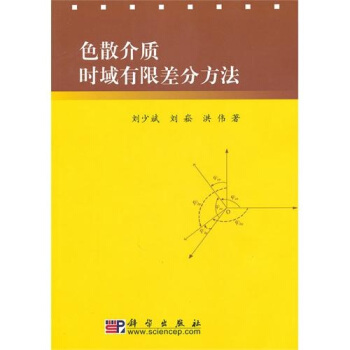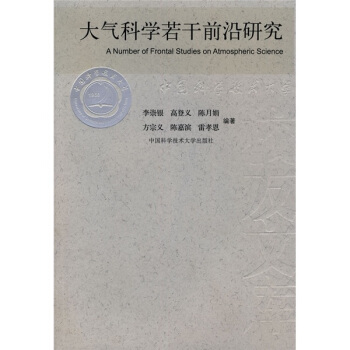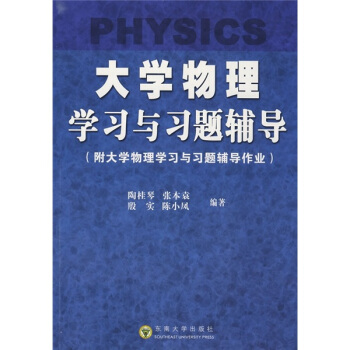![复分析(英文影印版) [COMPLEX ANALYSIS]](https://pic.tinynews.org/10175905/7673ecbf-71e3-46be-9caf-9ca91682480f.jpg)

具体描述
内容简介
This book provides an introduction to complex analysis for students with some familiarity with complex numbers from high school. Students should be familiar with the Cartesian representation of complex numbers and with the algebra of complex numbers, that is, they should know that i2 = -1. A familiarity with multivariable calculus is also required, but here the fundamental ideas are reviewed. In fact, complex analysis provides a good training ground for multivariable calculus. It allows students to consolidate their understanding of parametrized curves, tangent vectors, arc length, gradients, line integrals, independence of path, and Greens theorem. The ideas surrounding independence of path are particularly difficult for students in calculus, and they are not absorbed by most students until they are seen again in other courses.内页插图
目录
PrefaceIntroduction
FIRST PART
Chapter 1 The Complex Plane and Elementary Functions
1.Complex Numbers
2.Polar Representation
3.Stereographic Projection
4.The Square and Square Root Functions
5.The Exponential Function
6.The Logarithm Function
7.Power Functions and Phase Factors
8.Trigonometric and Hyperbolic Functions
Chapter 2 Analytic Functions
1.Review of Basic Analysis
2.Analytic Functions
3.The CauChy-Riemann Equations
4.Inverse Mappings and the Jacobian
5.Harmonic Functions
6.Conformal Mappings
7.Fractional Linear Transformations
Chapter 3 Line Integrals and Harmonic Functions
1.Line Integrals and Greens Theorem
2.Independence of Path
3.Harmonic Conjugates
4.The Mean Value Property
5.The Maximum Principle
6.Applications to Fluid Dynamics
7.Other Applications to Physics
Chapter 4 Complex Integration and Analyticity
1.Complex Line Integrals
2.Fundamental Theorem of Calculus for Analytic Functions
3.Cauchys Theorem
4.The Cauchy Integral Formula
5.Liouvilles Theorem
6.Moreras Theorem
7.Goursats Theorem
8.Complex Notation and Pompeius Formula
Chapter 5 Power Series
1.Infinite Series
2.Sequences and Series of Functions
3.Power Series
4.Power Series Expansion of an Analytic Function
5.Power Series Expansion at Infinity
6.Manipulation of Power Series
7.The Zeros of an Analytic Function
8.Analytic Continuation
Chapter 6 Laurent Series and Isolated Singularities
1.The Laurent Decomposition
2.Isolated Singularities of an Analytic Function
3.Isolated Singularity at Infinity
4.Partial Fractions Decomposition
5.Periodic Functions
6.Fourier Series
Chapter 7 The Residue Calculus
1.The Residue Theorem
2.Integrals Featuring Rational Functions
3.Integrals of Trigonometric Functions
4.Integrands with Branch Points
5.Fractional Residues
6.Principal Values
7.Jordans Lemma
8.Exterior Domains
SECOND PART
Chapter 8 The Logarithmic Integral
1.The Argument Principle
2.Rouches Theorem
3.Hurwitzs Theorem
4.Open Mapping and Inverse Function Theorems
5.Critical Points
6.Winding Numbers
……
THIRD PART
Hints and Solutions for Selected Exercises
References
List of Symbols
Index
前言/序言
This book provides an introduction to complex analysis for students with some familiarity with complex numbers from high school. Students should be familiar with the Cartesian representation of complex numbers and with the algebra of complex numbers, that is, they should know that i2=-1. A familiarity with multivariable calculus is also required, but here the fundamental ideas are reviewed. In fact, complex analysis provides a good training ground for multivariable calculus.It allows students to consolidate their understanding of parametrized curves, tangent vectors, arc length,gradients, line integrals, independence of path, and Greens theorem. The ideas surrounding independence of path are particularly difficult for students in calculus, and they are not absorbed by most students until they are seen again in other courses.The book consists of sixteen chapters, which are divided into three parts.The first part, Chapters I-VII, includes basic material covered in all undergraduate courses. With the exception of a few sections, this material is much the same as that covered in Cauchys lectures, except that the emphasis on viewing functions as mappings reflects Riemanns influence. The second part, Chapters VIII-XI, bridges the nineteenth and the twentieth centuries. About half this material would be covered in a typical undergraduate course, depending upon the taste and pace of the instructor. The material on the Poisson integral is of interest to electrical engineers, while the material on hyperbolic geometry is of interest to pure mathematicians and also to high school mathematics teachers. The third part, Chapters XII-XVI, consists of a careful selection of special topics that illustrate the scope and power of complex analysis methods. These topics include Julia sets and the Mandelbrot set, Dirichlet series and the prime number theorem, and the uniformization theorem for Riemann surfaces. The final five chapters serve also to complete the coverage of all background necessary for passing PhD qualifying exams in complex analysis.
用户评价
这本书在外观上就给人一种非常“扎实”的感觉。封面设计相当经典,简约的英文书名“COMPLEX ANALYSIS”并没有太多花哨的装饰,但却透着一股严谨的气息,让人觉得这是一本不容小觑的学术著作。我特别注重书籍的阅读体验,而这本书的纸张手感非常棒,厚实且带有微微的颗粒感,翻页时发出清脆的声响,这种细微之处的处理,都体现了其品质。印刷质量也很高,文字清晰锐利,行距和字号的安排也十分合理,长时间阅读不易产生视觉疲劳。握在手里,能感受到它沉甸甸的分量,仿佛里面蕴含着丰富的数学知识宝藏,让人充满探索的动力。它就像一位老朋友,虽然不言不语,却总能在你最需要的时候,提供最坚实的支撑。
评分拿到这本书后,我最直观的感受就是它的“厚重感”。当然,这里的厚重感并非指纸张的薄厚,而是内容深度所带来的那种沉甸甸的学术氛围。封面设计简洁大方,没有过多的装饰,却透着一股严谨的气质,英文原版的名字“COMPLEX ANALYSIS”本身就带着一种不可撼动的地位感。我一直以来都对手头上的数学书籍有着比较高的要求,不仅仅是内容的准确性,更是其呈现方式是否能激发读者的求知欲。这本书的排版布局非常清晰,文字大小适中,段落之间的间距也恰到好处,读起来非常舒适,不会因为密密麻麻的文字而产生阅读障碍。我常常会在深夜,在昏黄的台灯下,捧着它,那种感觉就像是在与一位深邃的智者对话,即使尚未深入内容,仅仅是这种纯粹的学术气息,就足以让人心生敬意,仿佛能感受到数学家们严谨的思维和不懈的探索精神。
评分这本书的装帧设计真是令人惊艳,书页泛着一种温暖的米黄色,触感厚实而细腻,即使在灯光下也不会反光,长时间阅读眼睛也不会感到疲劳。封面上“COMPLEX ANALYSIS”几个字的设计更是点睛之笔,烫金的工艺在不同角度下折射出迷人的光泽,散发出一种沉静而又专业的学术气息。我尤其喜欢它左上角的英文小标题,采用了一种比较复古的衬线字体,仿佛在低语着这座数学殿堂的悠久历史。整体而言,这本书拿在手里就有一种沉甸甸的质感,仿佛承载着知识的重量,让人充满期待。我对手边的许多经典教材都颇为挑剔,但这本书在外观上就已经足够吸引我,让人迫不及待地想要翻开它,去探索其中蕴含的奥秘。包装也非常到位,快递小哥送来的时候,严实的纸箱和内部的缓冲材料让书本完好无损,这种细致入微的处理,也体现了商家对产品的重视。
评分这本书给我的第一印象是它所散发出的那种经典著作的沉稳气质。封面设计非常耐看,那种简洁的英文标题,没有任何花哨的修饰,却能精准地传达出其核心内容。我是一个对书籍装帧比较挑剔的人,而这本书的纸张触感非常棒,不是那种过于光滑的,而是带有一点点涩感,翻阅起来非常有质感,而且不易反光,长时间阅读也不会让眼睛感到疲劳。拿到手里,能明显感觉到它的分量,仿佛里面承载着无数精深的数学思想。我一直都喜欢那些经过时间沉淀的经典教材,因为它们往往凝聚了前人的智慧和经验,而这本书无疑就具备了这样的特质。它就像一个默默伫立在知识殿堂深处的灯塔,指引着每一个渴望探索复分析领域的人。
评分这本书的封面设计透露出一种沉静而专业的学术气息,简洁的英文书名“COMPLEX ANALYSIS”直接点明了主题,让人一眼就能识别其学科归属。我个人比较偏爱这种不落俗套的设计风格,没有过多的浮夸元素,而是将重点放在了内容本身。书页的材质非常考究,纸张厚实且富有韧性,翻阅起来手感极佳,而且印刷清晰,文字边缘锐利,即使长时间阅读,眼睛也不会感到明显的疲劳。我常常会在书桌前,一边品味着咖啡,一边翻阅它,那种感觉就像是在与一位经验丰富的导师进行一场无声的交流。它的存在本身,就给人一种可靠而深厚的学术积淀感,仿佛每一次翻动,都能触碰到知识的脉搏。
评分good……
评分这一套书很值得收藏,都比较难
评分还行
评分还可以的啊还可以的啊
评分good……
评分虽是本科教材但写的很不错
评分质量很好,服务很到位!
评分joly
评分还行
相关图书
本站所有内容均为互联网搜索引擎提供的公开搜索信息,本站不存储任何数据与内容,任何内容与数据均与本站无关,如有需要请联系相关搜索引擎包括但不限于百度,google,bing,sogou 等
© 2025 book.idnshop.cc All Rights Reserved. 静思书屋 版权所有



















![代数K理论及其应用 [Algebraic K-Theory and Its Applications] pdf epub mobi 电子书 下载](https://pic.tinynews.org/10515947/e5e0ce20-0935-4e7a-855c-47ae1f97a2c0.jpg)
